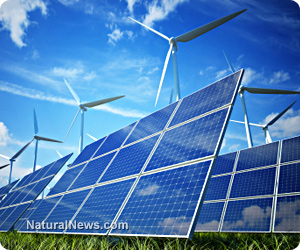Renewable energy has doubled in the U.S. in the last decade; now generating nearly one-fifth of our electricity
03/11/2018 / By Edsel Cook

The Business Council for Sustainable Energy (BCSE) has been keeping an interested eye on the incredible growth of renewable energy in the U.S. over the past decade. According to its annual publication, renewable energy sources now generate nearly one-fifth of U.S. electrical generation, reported an EcoWatch article.
In its 2018 edition of Sustainable Energy in America Factbook, the BCSE said renewable energy output made up 18 percent of the overall energy mix in the country. If it sustains its rate of growth, renewables might be able to generate as much power as nuclear energy.
The fact book recorded that renewable energy sources generated 717 terawatt hours (TWh) of electricity in 2017. That’s an impressive increase of 14 percent compared to the previous year’s output of 629 TWh.
Hydro power accounted for much of this boost. The West Coast finally recovered from a prolonged period of drought in 2017, so hydroelectric stations in that region were able to return to normal operations.
This renewed hydro power output was augmented by new wind and solar generation projects that entered operational status in 2017. (Related: Texas city fully commits to 100 percent renewable energy goal by the year 2020.)
Coal and nuclear power continue downward trend
According to BNEF senior analyst Rachel Luo, renewables are now right behind nuclear energy, which provides 20 percent of the total power in the U.S. She also points out that the share of natural gas is going down as the power sector shifts toward decarbonization and renewable energy.
Charts provided by EcoWatch show that natural gas accounts for 32 percent of the sector. It is still the biggest source of electricity in the U.S., but it’s gone down by two percent.
Luo attributes the down-tick to a stall in load growth, a slight rise in the price of natural gas, and the increasing market penetration of renewable energy sources.
The biggest loser is coal. Once the dominant power provider in the U.S., it has been reduced to a 30-percent share of the entire sector as companies switched to cleaner natural gas for fossil fuels.
Coal enjoyed a brief break in 2017 because only six coal-fired power plants closed down last year. But the coal plants that are slated for shutdown account for 12.5 gigawatts (GW) of power, which hews close to the 15 GW lost during 2015.
Department of Energy Secretary Rick Perry’s proposal to bail out coal and nuclear power plants to achieve “grid stability” also fizzled out, so there’s no long-term reprieve for the two aging industries.
Natural gas and renewables on the rise
Most new electrical generation comes from natural gas and clean sources of power. The costs of wind and solar energy systems continue to go down with some regions finally crossing the symbolic “dollar-per-watt” threshold.
“The massive and historic transformation of the U.S. energy sector clicked into a higher gear in 2017,” Luo believes.
The meteoric rise in deployment of renewable energy sources, the faster growth of energy productivity and GDP, and the U.S. entry into the global liquefied natural gas market more than made up for uncertainty regarding new energy policies.
Despite new tariffs imposed on renewable energy, the BCSE fact book expected clean energy providers to weather the new costs over the long run.
Similarly, natural gas is benefiting from fairly stable growth, especially since the U.S. became a net exporter of the fuel in 2017.
The end result is that the U.S. is enjoying its lowest levels of greenhouse gas emissions in the last 25 years. American consumers are appreciating the more-or-less stable costs of electricity as well as the cleaner air.
Knowledge is power. So get more knowledgeable about power-related news at Power.News.
Sources include:
Tagged Under: Clean Energy, coal power, coal-fired power plants, electricity, green living, hydro power, hydroelectric power, natural gas, nuclear power, power grid, power source, renewable energy, renewables, solar energy, wind energy
RECENT NEWS & ARTICLES
COPYRIGHT © 2017 ENVIRON NEWS




















